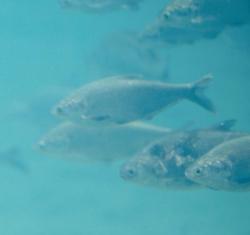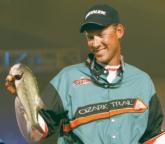Hanging shad
Once anglers find shad populations, bass are sure to follow.

It has been said, time and time again, that the way to a man’s heart is through his belly. There is nothing like a good home-cooked meal to take the stress off a hot summer day or a brisk afternoon spent working in the yard in late fall. The same holds true for bass. If you want to get to the heart of the bass in summer and especially in the fall, you have to consider their belly.
Any angler worth their salt knows that understanding a bass’s forage facilitates successful endeavors on the water. In late summer and fall, wily veterans concentrate their efforts on finding and catching bass on Southern impoundments by patterning their primary forage – shad. Shad behavior plays a major role in developing patterns for bass year-round, but it becomes especially important in summer and fall, when the bass are constantly migrating around the lake in search of these delicate baitfish.
Shad biology
The shad family in America is comprised of two major species and several smaller, more scattered species. The two primary species, threadfin shad and gizzard shad, share many common traits but also differ in some ways that will interest anglers. Understanding these subtle differences will help anglers dissect what today’s advanced electronics display in pixilated renderings of sonar echoes.
According to Colton Dennis, black-bass biologist for the Arkansas Game and Fish Commission, the most obvious difference between the shad species is their size.
“Threadfin shad adults rarely exceed 5 to 6 inches but can reach a maximum size of 9 inches, whereas the gizzard shad adults are usually 10 to 16 inches long and reach a maximum size of 20 inches and 3.5 pounds,” Dennis said.
Because of the threadfin’s manageable size, it is generally the optimal choice for bass on the prowl that are looking to load up for a long winter’s nap. Of course, big bass can still eat mature gizzard shad; however, the threadfin shad represents an easily attainable and digestible meal.
“They are both pelagic (open-water) schooling fish, but the threadfin shad occupies the layer of water between the surface and the thermocline during most of the year,” Dennis said.
This partly explains why shad will go deep in the summer. It also may help anglers understand when to start looking for bass migrating to the creeks in early fall. It is simply a matter of climate control. Just like most Texans do not like to stand on the asphalt parking lot in the scorching heat of summer for very long, shad will not stay in climatically unappealing depths unless forced.
 Gizzard shad occupy the same areas in the water column as well as on the bottom. This primarily has to do with its feeding tendencies versus that of a threadfin. While both will feed on phytoplankton and zooplankton in the first 5 feet of the water column, Dennis explains that gizzard shad also feed on detritus, or leaf litter, on the bottom of the water column. So while you may see shad down as deep as 50 feet, many times these will be the larger gizzard shad. However, those schools of shad in and above the thermocline will most likely be the more easily accessible threadfin shad.
Gizzard shad occupy the same areas in the water column as well as on the bottom. This primarily has to do with its feeding tendencies versus that of a threadfin. While both will feed on phytoplankton and zooplankton in the first 5 feet of the water column, Dennis explains that gizzard shad also feed on detritus, or leaf litter, on the bottom of the water column. So while you may see shad down as deep as 50 feet, many times these will be the larger gizzard shad. However, those schools of shad in and above the thermocline will most likely be the more easily accessible threadfin shad.
According to Dennis, gizzard shad become more bottom-oriented fish as they mature, seeking to consume more organisms associated with the bottom substrate rather than those found at the surface. Temperature also plays a role in where the shad will be found. Threadfin are especially temperate in nature. Temperatures dipping into the low 40s cause large shad die-offs. That is why the threadfin shad is found mostly in Southern waters from Florida to Texas and as far north as the southern part of Illinois. Gizzard shad are much more adaptable and have been found as far north as Canada, ranging from New Mexico to the East Coast.
Other factors to consider in finding shad during the summer and fall would be water fertility and weather. Obviously the more fertile the water and the more readily available the cover, the more likely shad will be in the area. Phytoplankton, also known as microscopic free-floating algae, and zooplankton, also known as microscopic animal life, will both be more readily available to shad in fertile waters. Cover offering spawning habitat and protection from predators helps shad to flourish in an area as well.
Dennis also points out that sunlight will increase phytoplankton and zooplankton activity, thus bringing shad closer to the surface. However, shad are more likely to skim the water’s surface under low-light conditions and when water temperatures fall in their comfort zone of 60 to 80 degrees.
Wind will also dictate where shad will congregate. “Threadfin shad are found more often in waters with a noticeable current, and large numbers of threadfin shad have been found to congregate below dams in the spring and fall,” Dennis said.
Their preference for current makes them susceptible to windblown points and humps, and oftentimes these schools will blow into a bank and eventually get pinned by aggressive schooling bass.
OK, so now we know what shad eat and what drives them around the lake. So when you are faced with 40,000 acres of water to dissect in late summer, where do you start? Wal-Mart FLW Tour pro Andy Morgan of Dayton, Tenn., has fished most of his life and has thus developed a plan for dissecting a lake based on seasonal patterns and experience.
“During the summer, the first place you pick up shad is on your electronics,” Morgan said. “A lot of times the shad are relating to ledges when ledge-fishing is good during the summer.”
Morgan believes the shad use the ledges and cover on the structure just like the predator fish do. When the shad flap their tails along the surface and wander seemingly without purpose, the Tennessee angler finds the bite gets a bit tougher. However, during summer he maximizes productivity by seeking out ledges and humps that offer quick drops into the river channels that the shad are using as migration routes.
“One of the best shad imitators made is a jigging spoon,” Morgan said. “It doesn’t take many drops to catch them on a spoon. Five or six pulls of the bait, and you can identify on your graph whether it’s white bass or largemouth down there feeding.”
While he admits a jigging spoon can quickly identify fish in a specific spot during the summer, he employs a deep-diving crankbait or heavy spinnerbait to cover larger humps or ridges more efficiently.
Falling shad
As summer progresses into fall, Morgan modifies his approaches to suit the seasonal migrations and moods of both the shad and the bass. The bass become more aggressive feeders, looking to stockpile their fat supplies for a long winter’s nap. The shad, now moving into shallower areas to feed, tend to migrate into the major tributaries and bays, according to Morgan.
“I never have understood why exactly, but in Tennessee, the bass and shad start migrating into the creeks as early as August,” Morgan said.
This time of year, Morgan moves to more aggressive, horizontal shad imitators like lipless crankbaits and waking spinnerbaits but acknowledges the power of more finesse baits in clear water.
“In clear water, I think the best shad imitator when fish are schooling is a Zoom Super Fluke,” Morgan said. “It seems like the bass will come a long way to get it. You’ll finally catch one, and there will be four or five bass with him, like it was a race to get to it.”
Morgan agrees with Dennis that the wind and sun play important roles in how shad behave in the fall. “In the fall, the shad seem to ball up better if the sun is up when they start to come back shallow,” Morgan said.
Experience has also shown that shad imitators like spinnerbaits or lipless crankbaits become more effective when the wind blows. While there are varying opinions on why that is, most will agree that a little chop on the water makes the bass more aggressive and the lures more lifelike.
Following shad from summer to fall can be quite cumbersome but very rewarding. The benefits to understanding how the bass relate to shad these times of year far outweigh the expense of time and effort when it improves the quality of fish caught. While there are obvious exceptions to any rule, these simple guidelines have proven effective for numerous professional and amateur anglers alike.
Hunger drives all animals to erratic behavior. Now factor in the effects of that erratic behavior on the food source, and it can make for a feast or famine on the lake. Successful anglers like Andy Morgan keep it simple, catching fish in areas where he finds shad and bass looking to satisfy hunger pangs.
Keying on other bass to find shad
An often-overlooked key to finding shad is finding feeding white bass. Most anglers get irritated when they start catching white bass on every cast. Andy Morgan feels it is a sign that the baitfish are in the immediate area.
“White bass are a key to finding shad sometimes,” Morgan said. “When I made the top six on Kentucky Lake earlier this year, I would start every morning on my best ledge. I’d pull in there and weed through several white bass before I started catching the blacks.”
White bass will attack all the same lures that the pros use to imitate shad, from jigging spoons to crankbaits to spinnerbaits. They are ferocious eaters, and many times when they are feeding in an area, the black bass simply move below them for an easy shot at leftovers.
Believe it or not, you can even distinguish them on your graph. Most of the time, large schools of white bass will appear as large black specks, and generally the sonar catches just a glimpse of the white bass as it tears through the shad. The result is a screen full of black blotches where you would normally find lines marking fish.
While some anglers had their hopes squashed after finding a white pulling on the other end of their line, Morgan thinks of them as a blessing. “If you start catching white bass on four or five casts that’s a good thing,” Morgan said.
Feeding whites means shad are present. Where there’s shad, there’s bass.
